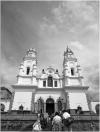Abstract
AbstractThis article critically evaluates the record of the intangible cultural heritage of Ecuador, conducted within the National Inventoryof Cultural Property in the country. Specifically with regard to the definition of intangible cultural heritage established byunesco and its classification in areas and sub areas, the manuscript indicates the problems that the application of these criteriaresulted in the inventory, which results in a projected image of the fragmented and dispersed national cultural heritage and,therefore, of culture, whose patrimonial monuments under criteria tends to solidify. This is taken as an example the inventoryof the sanctuary of the Virgin of El Quinche.Apuntes is registered under a Creative Commons Attribution 4.0 International Public License. Thus, this work may be reproduced, distributed, and publicly shared in digital format, as long as the names of the authors and Pontificia Universidad Javeriana are acknowledged. Others are allowed to quote, adapt, transform, auto-archive, republish, and create based on this material, for any purpose (even commercial ones), provided the authorship is duly acknowledged, a link to the original work is provided, and it is specified if changes have been made. Pontificia Universidad Javeriana does not hold the rights of published works and the authors are solely responsible for the contents of their works; they keep the moral, intellectual, privacy, and publicity rights.
Approving the intervention of the work (review, copy-editing, translation, layout) and the following outreach, are granted through an use license and not through an assignment of rights. This means the journal and Pontificia Universidad Javeriana cannot be held responsible for any ethical malpractice by the authors. As a consequence of the protection granted by the use license, the journal is not required to publish recantations or modify information already published, unless the errata stems from the editorial management process. Publishing contents in this journal does not generate royalties for contributors.

